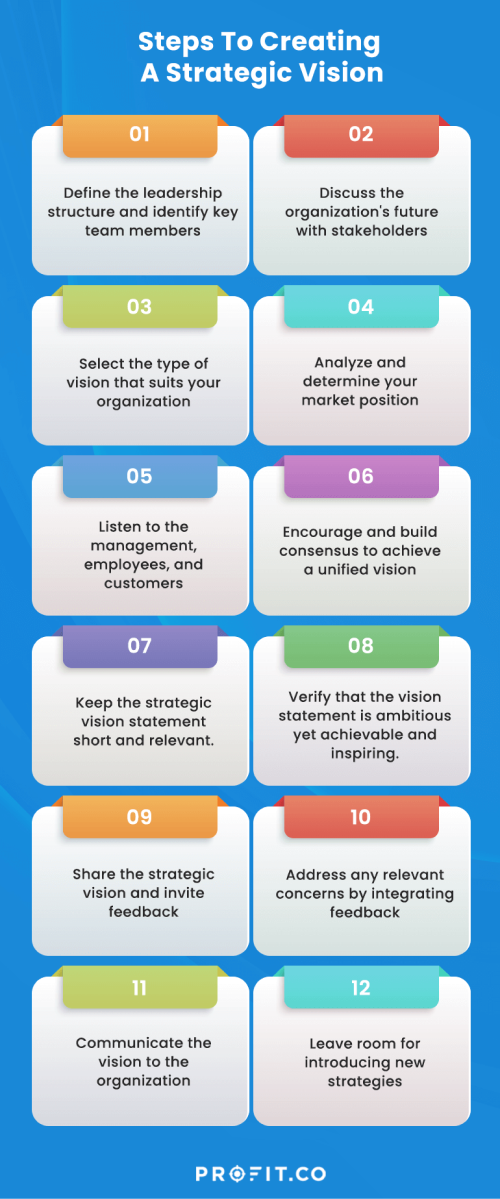Suppose you want to achieve something big as an organization. In that case, you should clearly define your values and goals, communicate them effectively with your employees, and align them to a common purpose.
You can do the heavy lifting as an organization only when you mobilize your employees to work towards a shared goal to achieve collectively. A strategic vision helps you achieve it.
A well-crafted strategic vision is akin to a compass for your employees, giving them a sense of direction and purpose as they set and achieve individual and organizational goals. In contrast, a lack of a strategic vision results in a lack of clarity on the mission, goals, strategies, and implementation plans at all levels of the organization.
Creating a strategic vision takes a lot of time and effort. But the benefits outweigh the pain, as you are more likely to succeed and thrive long-term with a well-defined strategic vision.
In this article, we will explore strategic vision, analyze why organizations need one to be successful, and list the steps involved in creating a strategic vision.
What is Strategic Vision?
Strategic vision refers to an actionable long-term plan that governs the entire organization, its goal-setting, and outcomes and reflects the intent of the organization and the direction in which it should travel to be where it wants to be in the future. A strategic vision involves clear and ambitious goal-setting and identifying the means to achieve business objectives through strategies and tactics.
The strategic vision produces a roadmap to navigate the challenges, starting from the current state of the organization, as well as based on the forecasts made on future trends and challenges. It acts as the basis for decision enablement, resource allocation, and prioritization of tasks and activities to achieve the desired outcomes.
Manage the top line: your strategy, your people, and your products, and the bottom line will follow.
Importance of Strategic Vision
The strategic vision acts as a guideline for all activities in an organization. It provides a clear direction and reflects core values that drive decisions, goal-setting, and outcomes. It helps to bring employees towards a common purpose. It enables the leaders to consolidate the employees’ efforts at an individual level to create collective outcomes and fulfill organizational objectives.
A strategic vision is crucial for the organization in the following ways.
1. Purpose and mission
When you finalize a strategic vision for your organization, it flows logically into a clearly articulated mission, purpose, strategy, and tactics. Communicating with the employees and convincing them to buy into this shared purpose and mission clarifies what they need to do and the outcomes they need to achieve. It acts as a guideline for employees and stakeholders to set smart goals aligned with the organizational objectives.
2. Decision-making
Business-critical decisions are not taken randomly; the strategic vision dictates these decisions. A strategic vision helps leaders, board members, and decision-makers make informed choices and decisions to meet the organization’s long-term goals.
For example, when an organization has a strategic vision to be the top customer-centric company in the industry, all decisions are taken around that core value. For instance, the company may set strategic goals to prioritize customer care and support, user experience, and personalization and get the best Customer Relationship Management software available. In the end, all that serves to fulfill one strategic vision.
The key to keeping the employees motivated is showing them the scope of their work, the impact they will create, and the growth they will achieve collectively and individually. A strategic vision provides employees with a purpose and a sense of direction. It gives them an idea of the future they will create for the organization while also benefiting individually. It shows them how their work will contribute to the organization’s long-term success. This inspires and motivates the employees to take ownership of the activities as individuals and teams and produce the best outcomes to realize the vision.
For example, the strategic vision of Google is “to organize the world’s information and make it universally accessible and useful.” Such an ambitious strategic vision inspires the employees and clarifies what they can achieve. It motivates them and gives them the impetus to innovate constantly and develop new technologies to achieve their goals.
3. Differentiation
While competing in the same market with similar products and services, there is a danger of companies looking the same and competing for the same market share without any differentiation. A clear strategic vision helps organizations set themselves apart from their competitors by identifying unique value propositions and areas of focus. For instance, Volvo has a strategic vision to ensure that “no one should be killed or seriously injured in a new Volvo car,” which sets them apart from other automakers and positions them as a leader in safety.
4. Enables effective resource allocation
An organization has many priorities. Strategic vision ensures the reasonable allocation of resources to each of those priorities to achieve long-term goals. For example, when Facebook changed its company name to Meta, it had a strategic vision to establish Metaverse “as the successor to the mobile internet – a set of interconnected digital spaces that lets you do things you can’t do in the physical world.” In line with this vision, the company invested a significant amount of resources not just in software development as the company did in the past but also in making VR hardware.
Bridge the Strategy Execution Gap with Profit.co
What is the Difference Between Vision, Strategic Vision, Strategy, and Tactics?
A vision of a company is a broad, aspirational statement that describes the future that the organization wants to create and be a part of. It defines what your organization stands for, how it wants to be perceived by its stakeholders, and what it wants to achieve in a broader sense. A vision is similar to a long-term goal of an organization.
A strategic vision is a specific, actionable statement that translates an organization’s broad vision into a practical, action-oriented one. It includes concrete objectives, goal-setting, and strategies that guide operations, activities, and resource allocation. A strategic vision provides a roadmap for an organization’s vision.
Strategy is the plan that details the means to achieve the goals and objectives derived from a strategic vision. It lays out an action plan with activities, actions, and decisions an organization should take to achieve its goals. It involves making choices such as the markets you should compete in, how to leverage and promote your unique strengths, how to position your brand, how to compete with rivals, and how to manage risks and uncertainties. Strategy is a continuous process that requires changes to accommodate and adjust to external and internal factors.
Tactics are the specific actions and plans designed to implement the strategy and achieve your organization’s strategic goals and objectives. In contrast to the strategy that lays out the overall plan to achieve long-term objectives, tactics break down the strategic planning into specific steps for strategy implementation.
For example, if a textile company has:
- A vision to become the market leader in sustainable fashion, then
- The strategic vision may include objectives such as developing eco-friendly products with minimal or no environmental impact, creating a sustainable supply chain, gradually transitioning to 100% alternative energy over time, and implementing a zero-waste policy in manufacturing.
- The strategy may involve purchasing green energy, developing processes and methods to manufacture products from sustainable materials, collaborating with suppliers, logistics partners, and stakeholders to create a sustainable supply chain, and building a brand identity around sustainability.
- Tactics would involve using sustainable materials such as organic cotton, bamboo, or recycled fabrics, developing new materials and production methods to convert plastic waste into eco-friendly products, reducing waste throughout the supply chain, hiring logistics companies that use electric trucks for transporting materials and products, investing in solar, wind, or other renewable energy sources to power manufacturing facilities, offices, and retail stores, increasing energy efficiency by installing LED lighting and intelligent building systems, redesigning products and identifying efficiencies at every stage of manufacturing, reusing and recycling materials wherever possible, and finally developing a marketing campaign that highlights your commitment to sustainability and educates consumers on the environmental impact of fashion.
Eleven Key Characteristics of an Effective Strategic Vision
A strategic vision must have specific qualities and standards to assist an organization in reaching its potential.
An effective strategic vision has the following qualities.
- Clear and compelling
A strategic vision should be clear, free from ambiguities, and easy to understand. It should present a compelling case for the employees and stakeholders to take ownership and accept it as a guideline for goal-setting and all their priorities and activities.
- Future-oriented
A strategic vision should focus on the future and be forward-thinking. It should consider the changes and trends in the industry or market and state where the company needs to head to.
- Aligned with core values
A strategic vision should align with the organization’s core values, mission, and purpose. It ensures continuity and relevance of what the company wants to pursue.
- Ambitious yet achievable
A strategic vision should aim high and be ambitious in what it aspires to achieve. At the same time, it should be achievable with the available resources.
- Flexible
Unlike the broader vision statement, a strategic vision needs to be flexible and adaptable to changes in the business environment and evolve as the needs and circumstances change.
- Communicated and aligned across the organization
A strategic vision is overarching and should reach all levels of the organization. It is essential to communicate effectively with all stakeholders. This includes employees, customers, partners, and investors. It should align everyone around the same vision and unite them to work toward the same goals.
- Backed by a clear strategy
A strategic vision is action-oriented and should be complemented by planning and creating a strategy, outlining the tasks and activities required to achieve the goals.
- Inspiring
A strategic vision should engage and inspire employees and stakeholders to take ownership of the vision and the objectives. It should be appealing and enticing enough for them to work towards outcomes and goals without requiring supervision and scrutiny.
- Motivating
The strategic vision should connect with the employees emotionally and motivate them to push the boundaries and realize the future you envision.
- Purpose-driven
A strategic vision gives a larger sense of organizational purpose. It provides an appealing common purpose for employees to plan every task, activity, and outcome to achieve something big.
- Unique
A unique strategic vision must set your organization apart from competitors.
What are the Steps Involved in Creating a Strategic Vision?
Creating a compelling strategic vision requires going through a process.
Following are the steps to create a strategic vision:
1. Define the leadership structure and identify key team members to assist with formulating the strategic vision.
2. Discuss with all the stakeholders regarding the organization’s future.
3. Assess the options and select the type of vision that suits your organization. For instance, a start-up tech company may aspire to bring revolutionary innovations to redefine the industry and change the course of the future. In contrast, an established company may want to build on its strengths, evolve its offerings and create sustained value without radically changing anything that works well.
4. Analyze your product offerings and determine your market position objectively.
5. Listen to the management, employees, and customers.
6. Encourage thorough discussions and debates among stakeholders, consider everyone’s perspective, and build consensus to achieve a unified, agreeable vision.
7. Keep the strategic vision statement short, relevant, and concise.
8. Verify that the statement is ambitious yet achievable and inspiring.
9. Share the newly formulated strategic vision with the employees, external consultants, key customers, and partners, and invite feedback.
10. Address any relevant objections or concerns by integrating feedback and getting everyone to agree.
11. Communicate the vision to the organization and the teams through various channels.
12. Leave room for introducing new strategies without changing the strategic vision and objectives.

FAQs
- What is a strategic vision with an example?
Strategic vision refers to an actionable long-term plan that governs the entire organization, its goals, and outcomes and reflects the organization’s intent and direction in which it should travel to be where it wants to be in the future.
Example: A non-profit organization may have an organizational vision to ensure access to clean drinking water for everyone. Its strategic vision will be to raise funds to support water infrastructure projects in developing countries, partnering with local organizations to ensure community participation, and monitoring and evaluating project outcomes to ensure sustainability.
- What are the three elements of strategic vision?
The three elements of strategic vision are core values, envisioned future, and strategy.
- Why is a strategic vision important?
A strategic vision is important because it provides the purpose and direction for the organization, aligns everyone towards common goals, and enables effective decision-making and allocation of resources. It inspires and motivates employees, stakeholders, and customers toward a shared future.
- How do you create a strategic vision?
Following are the steps involved in creating a strategic vision.
- Identify key team members and put a leadership structure in place.
- Discuss with all the stakeholders and select the vision that suits your organization.
- Analyze product offerings and market position objectively.
- Listen to the management, employees, and customers, discuss and build consensus before drafting a strategic vision statement.
- Once you write it, get stakeholders’ feedback, incorporate their views to make changes, and refine the statement. Get consensus.
- Finalize the statement and communicate the vision to the organization and the teams through various channels.
Conclusion
A strategic vision is essential for organizational success, providing a clear direction and purpose. A strategic mission is important because it gives a purpose and mission, guides decision-making, inspires and motivates employees and stakeholders, differentiates a company from competitors, and achieves effective resource allocation. Creating a strategic vision for your team will inspire and drive your organization to new levels of success.

